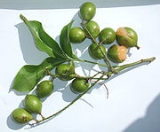
Mamoncillo
Overview
Fruit
In broad terms, a fruit is a structure of a plant that contains its seeds.The term has different meanings dependent on context. In non-technical usage, such as food preparation, fruit normally means the fleshy seed-associated structures of certain plants that are sweet and edible in the raw state,...
-bearing tree
Tree
A tree is a perennial woody plant. It is most often defined as a woody plant that has many secondary branches supported clear of the ground on a single main stem or trunk with clear apical dominance. A minimum height specification at maturity is cited by some authors, varying from 3 m to...
in the soapberry
Sapindus
Sapindus is a genus of about five to twelve species of shrubs and small trees in the Lychee family, Sapindaceae, native to warm temperate to tropical regions in both the Old World and New World. The genus includes both deciduous and evergreen species. Members of the genus are commonly known as...
family Sapindaceae
Sapindaceae
Sapindaceae, also known as the soapberry family, is a family of flowering plants in the order Sapindales. There are about 140-150 genera with 1400-2000 species, including maple, horse chestnut and lychee....
, native or naturalised over a wide area of the tropics, including South and Central America, Mexico, the Caribbean, and parts of Africa and the Pacific.
The genus Melicoccus was first described by Patrick Browne
Patrick Browne
Patrick Browne was an Irish physician and botanist.-Career:Browne was born in Woodstock, County Mayo, sent to relatives on Antigua in 1737 and returned to Europe due to ill health after two years. He studied medicine, natural history and especially botany at Reims, Paris and Leyden, qualifying...
, an Irish doctor and botanist, in 1756.

